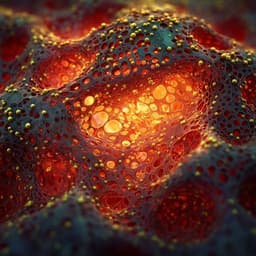
Engineering and Technology
Toward grouped-reservoir computing: organic neuromorphic vertical transistor with distributed reservoir states for efficient recognition and prediction
C. Gao, D. Liu, et al.
This groundbreaking research showcases an ultra-short channel organic neuromorphic vertical transistor that utilizes a distributed reservoir with 1152 states for advanced recognition and prediction capabilities. With over 94% recognition accuracy and over 95% prediction correlation, this device represents a significant leap in reservoir computing networks, led by a team of innovative researchers.
~3 min • Beginner • English
Introduction
The study addresses the limitations of current hardware implementations of reservoir computing (RC), which predominantly rely on shallow reservoirs with monotonic carrier dynamics. Such systems exhibit narrow spatial and temporal characteristic ranges, causing overlapping reservoir states and reducing separability of complex spatiotemporal inputs. Feed-forward neural networks struggle with temporal processing, while recurrent neural networks require backpropagation through time and suffer from training instability. The research question is whether a single neuromorphic device can provide distributed reservoir states with wide and tunable spatiotemporal dynamics to enable grouped-reservoir computing capable of high-accuracy recognition and prediction. The authors propose an organic neuromorphic vertical field-effect transistor with distributed reservoir states (VOFET-DR) to map input sequences into high-dimensional, distributed state spaces, simultaneously expanding temporal and spatial scales to improve RC performance across diverse tasks.
Literature Review
Prior RC hardware largely implements shallow reservoirs using memristors and lateral transistors, which typically yield monotonic state spaces, limited feedback strength, and narrow temporal ranges. Dynamic memristors have been effective for temporal processing but limited terminal configurations can make the reservoir a relatively fixed nonlinear function, constraining diversity of dynamics. Attempts to widen temporal scales by increasing input modalities in the input layer improve time features but do not address limited spatial characteristics and increase preprocessing complexity and error rates. Vertical transistor architectures and optoelectronic devices have shown potential for improved charge transport and tunability, but achieving both broad spatial and temporal ranges with distributed reservoir states in a single device had not been demonstrated. The work builds on advances in optoelectronic synapses, vertical organic transistors, and RC applications, aiming to couple multiple physical mechanisms (photogeneration, trapping, gate-modulated injection) in one node to realize distributed mapping and grouped-RC.
Methodology
Device and materials: The VOFET-DR uses a vertical field-effect transistor with an organic bulk heterojunction (BHJ) active layer composed of POFDIID (p-type, broad-spectrum absorber) and N2200 (n-type acceptor/trap), channel thickness ~65 nm. MXene thin-film (perforated) forms the source, Al2O3 (1 nm)/PVA serves as a charge-trapping dielectric, and Au is used for electrodes. The vertical architecture shortens transport distance and enhances electric fields to promote exciton dissociation and carrier transport.
Operating modes and measurements: Three operating modes map temporal characteristics into reservoir spaces: (1) voltage pulse input (VG pulses), (2) light pulse input (various wavelengths), and (3) combined gate bias with light pulses. Transfer and hysteresis (double-sweep) curves confirm gate control and memory effects. Short-term memory currents are elicited by VG pulses of different amplitudes and by single light pulses at multiple wavelengths, extracting nonlinear temporal characteristics τ (Supplementary Note 2). Feedback strength is quantified as FE = ΔPspike_out/Pin for electrical pulses and Fph = ΔIspike_out/Plight_in for light pulses (Supplementary Note 3), using standard deviation to assess variation.
Nonlinear mapping tests: A 6-bit optical sequence (periodic 650 nm pulses, 0.01 mW cm^-2, 0.1 s width, 0.2 s interval) encodes 64 binary patterns from 000000 to 111111. The device maps distinct sequences to distinct conductance states, demonstrating separable reservoir states for multi-bit sequences.
Distributed reservoir via bias and wavelength: With light pulses and varied VGS biases, τ spans from ~0.005 s up to ~13.2 s and Fph increases strongly with more negative VGS. Distinct reservoir state spaces X_(VGS)(t) are formed under different gate biases and wavelengths (UV 310 nm, Vis 650 nm, NIR 808 nm). Combining 3 wavelength bands with multiple VGS conditions yields 1152 reservoir states. The standard deviation across states quantifies linear separability improvements. Effects of wavelength- and gate-controlled dynamics on state overlap and separability are analyzed.
Mechanism studies: The role of N2200 is probed by control devices without N2200, which lack light-induced memory. Activation energies Ea for trapping under different wavelengths are extracted (Arrhenius analysis), showing higher Ea for longer wavelengths correlating with weaker memory currents. KPFM surface potential mapping under different wavelengths corroborates wavelength-dependent electron trapping. Temperature-dependent measurements and thermionic emission modeling quantify Schottky barrier modulation with VGS. COMSOL simulations analyze potential and hole current density distributions, showing gate-induced virtual contact formation in apertures and enhanced injection.
Grouped-RC architecture for vision tasks: For satellite remote sensing image recognition, UV/Vis/NIR channels are preprocessed (crop, binarize, resize) into 16×100 images. The reservoir consists of 4 parallel sub-reservoirs (VGS = 0, -3, -8, -10 V), each with 100 VOFET-DR nodes, producing 100 features per sub-reservoir (total 400 features). Features are fused and fed to a fully connected output layer (size 400×6). Training uses MATLAB Deep Learning Toolbox with Softmax output and logistic regression.
Trajectory prediction: For traffic scenes, optical flow and inter-frame difference extract motion rate (temporal) and orientation (spatial) information. A VOFET-DR array P(n,m) receives spatiotemporal input sequences aligned to image resolution. The encoding system uses velocity and coordinate information from three prior frames X(t0), X(t1), X(t2) to predict the next frame’s velocity and coordinates.
Fabrication and characterization details: Substrate cleaning, PVA/Al2O3 dielectric stack deposition, MXene source preparation, POFDIID:N2200 spin-coating and anneal, Au drain evaporation; characterization with Keysight analyzers, AFM, UV-Vis-NIR spectrophotometry, SEM, and KPFM. Dataset: Hyperspectral Remote Sensing Scenes; 10 scenarios selected per landform type; grayscale coding to light pulses for device input.
Key Findings
- Device-level state space and ranges: The VOFET-DR maps sequences into 1152 distributed reservoir states by combining multiple wavelengths (UV 310 nm, Vis 650 nm, NIR 808 nm) and various VGS biases. Temporal and spatial characteristic range ratios reach 2640 and 650, respectively, surpassing reported neuromorphic RC devices.
- Temporal dynamics: τ under VG pulse mode is narrow (0.14–0.39 s), while τ under light pulse mode is broader (0.005–1.72 s). With added gate bias, τ extends up to ~13.2 s, enabling multi-scale temporal processing.
- Feedback strength: Light-pulse mode exhibits richer feedback variation (SD ≈ 280.6) than electrical pulse mode (SD ≈ 15.5). At 310 nm, Fph increases with VGS magnitude: ~6.3, 13.8, and 54.6 µA/(mW cm^-2) for VGS = -1, -8, -15 V, respectively. Gate control yields up to ~190× increase in feedback intensity compared to no-gate case.
- Efficient nonlinear mapping: The device distinguishes all 64 six-bit sequences (000000–111111), producing distinct conductance states and enabling linear separability improvements via bias and wavelength control.
- Mechanism validation: N2200 traps are essential for light-induced memory; Ea for trapping increases with wavelength (46, 61, 79, 91, 99 meV for 310, 450, 525, 650, 808 nm), correlating with reduced memory current at higher Ea. KPFM indicates wavelength-dependent electron concentration changes. Thermionic emission analysis shows gate-lowered Schottky barrier; simulations reveal gate-formed virtual contact and enhanced injection.
- Image recognition performance: Grouped-RC using UV/Vis/NIR channels and 4 sub-reservoirs achieves high accuracy on six remote sensing scenes, with recognition accuracy exceeding 95% (and ~94.9% after adding 4 sub-reservoirs). Compared baselines: single-layer ANN 88.1%, double-layer ANN 96.1%, CNN 92.1%.
- Model efficiency: Grouped-RC trains only output weights, using ~2400 weights vs ~1,440,288 (single-layer ANN), ~2,884,896 (double-layer ANN), and ~25,600 (CNN), reducing weight-related computation by >90% while achieving comparable accuracy.
- Trajectory prediction: Predicted motion trajectories for pedestrians, bicycles, and cars closely match ground truth, with correlation coefficients 0.951, 0.959, and 0.969, respectively.
- Power considerations: Additional gate-induced power density is negligible (on the order of ~10^-3 mJ s^-1 cm^-2) relative to the achieved feedback enhancement.
Discussion
The proposed VOFET-DR addresses the core challenge in physical reservoir computing of achieving rich, diverse, and tunable reservoir dynamics. By coupling photogeneration, wavelength-dependent trapping, and gate-modulated injection within an ultra-short-channel vertical architecture, the device expands both temporal and spatial characteristic ranges. This distributed reservoir state space enables grouped-reservoir computing, where different sub-reservoirs (set by wavelength and VGS) capture complementary features of spatiotemporal signals, improving separability and downstream performance. The approach translates into strong results on two distinct task types: high-accuracy recognition of complex hyperspectral scenes and accurate prediction of traffic trajectories with high correlation to ground truth. Importantly, the RC paradigm requires training only a small output layer, maintaining computational efficiency while delivering performance comparable to or exceeding standard ANN/CNN baselines. The findings demonstrate that hardware-level enhancement of feedback intensity and time constants can unlock broader RC capability across heterogeneous tasks, highlighting the significance of device-architecture co-design for neuromorphic computing.
Conclusion
This work introduces an organic vertical neuromorphic transistor (VOFET-DR) that realizes distributed reservoir states suitable for grouped-reservoir computing. The device achieves 1152 reservoir states with ultra-wide temporal (range ratio 2640) and spatial (range ratio 650) characteristics, surpassing prior reservoirs. Grouped-RC built on VOFET-DR attains over 94–95% accuracy on remote sensing image recognition and ~0.95–0.97 correlation on traffic trajectory prediction, while reducing trainable weights by over 90% compared to ANN/CNN baselines. The mechanism is validated via control devices, activation energy analysis, KPFM, temperature-dependent transport modeling, and COMSOL simulations, confirming wavelength- and gate-tunable carrier dynamics. Future work could pursue large-scale arrays and integration, broader task generalization (e.g., audio/time-series, multimodal fusion), on-chip learning/readout circuits, endurance/stability studies, and system-level co-design to further enhance robustness and scalability.
Limitations
- Scope of tasks and datasets: Demonstrations focus on selected hyperspectral remote sensing scenes and specific traffic scenarios; generalization to broader datasets and tasks is not evaluated here.
- Device-scale integration: Results are shown at device and modest array scales; large-scale uniformity, variability, and yield for extensive arrays are not reported.
- Long-term stability and endurance: The endurance, retention under continuous operation, and environmental stability of the POFDIID:N2200 BHJ and MXene-based electrodes are not detailed.
- Input modality constraints: Experiments rely on controlled optical pulse inputs at specific wavelengths; performance with real-world, noisy, or mixed-spectrum inputs and on-chip light integration remains to be assessed.
- Power metrics granularity: While additional gate power is reported as negligible, comprehensive system-level energy benchmarks (including optics and readout) are not provided.
Related Publications
Explore these studies to deepen your understanding of the subject.







